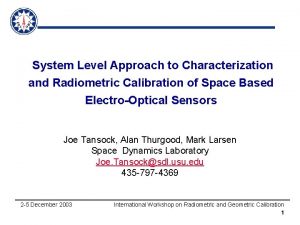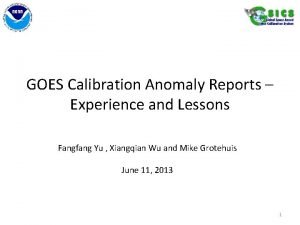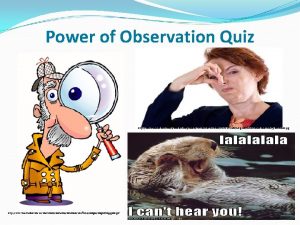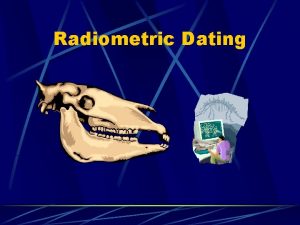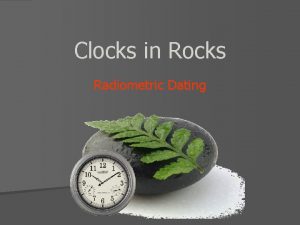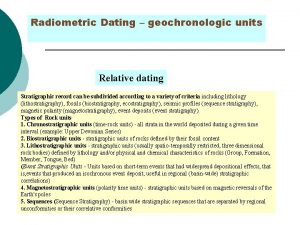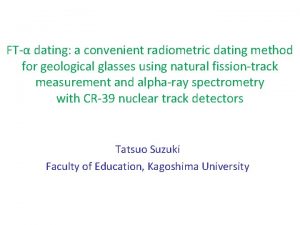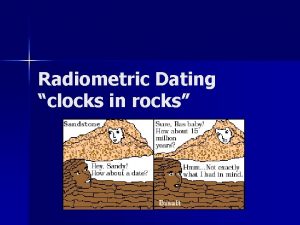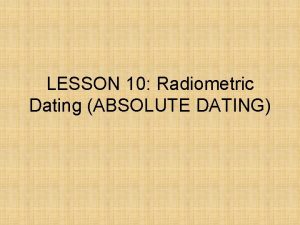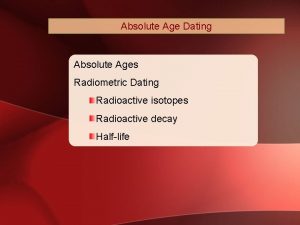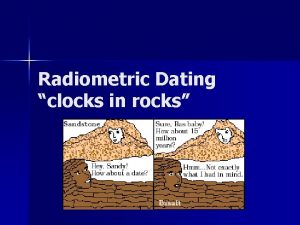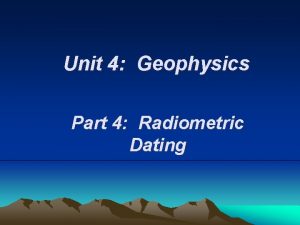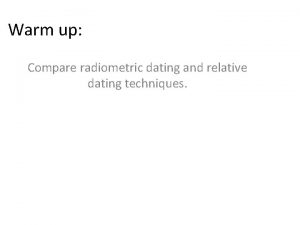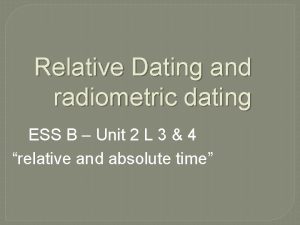Radiometric Dating Radiometric Dating You have visited museums



















- Slides: 19

Radiometric Dating

Radiometric Dating You have visited museums many times, and they show the ages of dinosaurs. Millions of years old, but how do they know? Here’s how they determine this.

Its All About Atoms It all starts in the nucleus of an atom Atoms, as you know, are made of smaller particles: protons, neutrons, & electrons.

Radioactive Decay Some of these atoms are unstable, meaning their nuclei may fall apart (so to speak), ejecting some of these particles to become new atoms. The atoms that do this are called radioactive atoms or radioisotopes.

Parent & Daughter Isotopes The radioactive atom is referred to as the parent isotope. The atom it changes into after nuclear decay is called the daughter isotope.

Radioisotopes You may never know which atom will decay and when, but there seems to be a fairly steady rate of decay, which we call a half-life. It is this steady rate that allows scientists to determine the age of a fossil.

Half-life is the time it takes for ½ of sample of radioactive atoms to decay. The half-life depends on the radioisotope. All isotopes of the same type have the same steady rate of half-life decay.

Radiometric Dating - Step 1 Determine Amount of Parent Left To determine the age of a rock, geologists must simply determine how long the radioisotopes in the rock have been decaying. To do this, they measure what percentage of the radioisotope is still left in the rock.

Radiometric Dating- Step 1 Compare Parent to Daughter Most of the time, this is done by comparing the amount of the parent isotope in the rock to the amount of the daughter in the rock. % P = Parent / Original Parent Orig Parent = Parent + Daughter

Radiometric Dating- Step 2 Determine Number of Half-lives From the percentage of the parent left, scientists are able to determine how long it has been decaying (since half-life is a constant rate). Referencing the half-life, we then see how much time it has taken. AGE = # Half-Lives x Half-life

Carbon Dating Carbon dating is the ONLY type of dating that can be done on formerly living organisms. Other types of radiometric dating can only be done on igneous rock (because sedimentary rock is bits and pieces of older rock – dating would not give the date of sedimentation. ) This is unfortunate because sedimentary rock is where we find the fossils.

Carbon Dating IS a form of radiometric dating, but it is done a little differently. Carbon-14 is a radioisotope of carbon that decays into Nitrogen -14. Nitrogen, being a gas, does not stay in the sample. It escapes into the atmosphere. There is no daughter element left to measure.

Carbon -14 Production Carbon-14 makes up 1 trillionth of the percentage of carbon on earth, and is created by cosmic radiation It is then absorbed by living plants and animals

How Carbon-14 is Produced Cosmic Rays (radiation) Forms C-14 Collision with atmosphere (N-14) C-14 combines with oxygen to form carbon dioxide (CO 2)

Carbon Dating When plants or animals die, they stop absorbing carbon. The unstable carbon-14 then decays into the stable nitrogen-14 atom. The stable carbon remains. (Carbon-12) Scientists compare the amount of carbon-14 to carbon-12.

Carbon Dating In order to estimate the original amount of carbon-14 in a sample, scientists look to life today. They assume that the same amount of carbon-14 that is in living beings today was originally in the sample being carbon-dated.

How to determine age All the scientist must do then is calculate this simple formula… t = [ ln (Nf/No) / (-0. 693) ] x t 1/2 …where ln is the natural logarithm, Nf/No is the amount of carbon-14 in the sample compared to the amount in living tissue, and t 1/2 is the half-life

Simple enough? Although, the formula may not be simple, hopefully the concept is. (Really it’s just looking at the percent of parent remaining in the organic sample. ) OR NOT?

Sources Illustrations taken from www. icr. org
 Carbon 14 decay equation
Carbon 14 decay equation How many states have you been to
How many states have you been to You have been visited by the legg
You have been visited by the legg Obj dating
Obj dating I have visited again poem
I have visited again poem How many spacecrafts have visited mercury
How many spacecrafts have visited mercury Resolution characteristics
Resolution characteristics Radiometric calibration
Radiometric calibration Radiometric error
Radiometric error Radiometric error
Radiometric error Archives and museums du study material
Archives and museums du study material Revenue generating ideas for museums
Revenue generating ideas for museums Famous museums of the world
Famous museums of the world Getty.edu
Getty.edu Royce hall
Royce hall Peace museums
Peace museums Utah museums association
Utah museums association They have not rejected you
They have not rejected you Which angel visited mary
Which angel visited mary When i visited phil finches of japan
When i visited phil finches of japan







